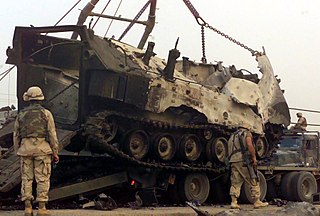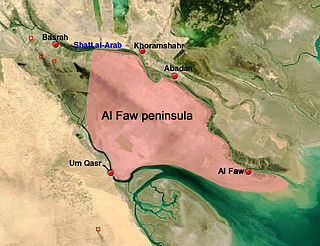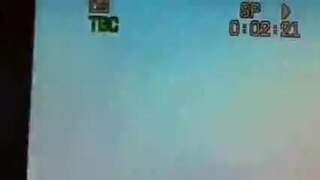
The Iraqi Republican Guard was a branch of the Iraqi military from 1969 to 2003, which existed primarily during the presidency of Saddam Hussein. It later became known as the Republican Guard Corps, and then the Republican Guard Forces Command (RGFC) with its expansion into two corps. The Republican Guard was disbanded in 2003 after the invasion of Iraq by a U.S.-led international coalition.

The Gulf War was an armed conflict between Iraq and a 42-country coalition led by the United States. The coalition's efforts against Iraq were carried out in two key phases: Operation Desert Shield, which marked the military buildup from August 1990 to January 1991; and Operation Desert Storm, which began with the aerial bombing campaign against Iraq on 17 January 1991 and came to a close with the American-led Liberation of Kuwait on 28 February 1991.

This is a timeline of the events surrounding the United States-led invasion of Iraq in 2003.

The United States-led invasion of the Republic of Iraq was the first stage of the Iraq War. The invasion phase began on 19 March 2003 (air) and 20 March 2003 (ground) and lasted just over one month, including 26 days of major combat operations, in which a combined force of troops from the United States, the United Kingdom, Australia and Poland invaded Iraq. Twenty-two days after the first day of the invasion, the capital city of Baghdad was captured by coalition forces on 9 April 2003 after the six-day-long Battle of Baghdad. This early stage of the war formally ended on 1 May 2003 when U.S. President George W. Bush declared the "end of major combat operations" in his Mission Accomplished speech, after which the Coalition Provisional Authority (CPA) was established as the first of several successive transitional governments leading up to the first Iraqi parliamentary election in January 2005. U.S. military forces later remained in Iraq until the withdrawal in 2011.

The Battle of Baghdad, also known as the Fall of Baghdad, was a military engagement that took place in Baghdad in early April 2003, as part of the invasion of Iraq.
On April 8, 2003, three locations in Baghdad housing journalists were fired upon by U.S. armed forces during 2003 invasion of Iraq, killing three journalists and wounding four.
Events in the year 2004 in Iraq.

The Battle of Norfolk was a tank battle fought on February 27, 1991, during the Persian Gulf War, between armored forces of the United States and United Kingdom, and those of the Iraqi Republican Guard in the Muthanna Province of southern Iraq. The primary participants were the U.S. 2nd Armored Division (Forward), 1st Infantry Division (Mechanized), and the Iraqi 18th Mechanized and 9th Armoured Brigades of the Republican Guard Tawakalna Mechanized Infantry Division along with elements from eleven other Iraqi divisions. The 2nd Armored Division(Fwd) was assigned to the American 1st Infantry Division as its 3rd maneuver brigade due to the fact that one of its brigades was not deployed. The 2nd Armored Division(Fwd)'s Task Force 1-41 Infantry would be the spearhead of VII Corps. The British 1st Armoured division was responsible for protecting the right flank of VII Corps, their main adversary being the Iraqi 52nd Armored Division and multiple infantry divisions. It was the final battle of the war before the unilateral ceasefire took effect.

The Battle of Abu Ghraib was a battle between Iraqi Mujahideen and United States forces at Abu Ghraib prison on April 2, 2005.

The Battle of Nasiriyah was fought between the US 2nd Marine Expeditionary Brigade and Iraqi forces from 23 March to 2 April 2003 during the US-led invasion of Iraq. On the night of 24–25 March, the bulk of the Marines of Regimental Combat Team 1 passed through the city over the bridges and attacked north towards Baghdad. However, fighting continued in the city until 1 April when Iraqi resistance in the city was defeated.

The Battle of Najaf was fought between United States and Iraqi forces on one side and the Mahdi Army led by Muqtada al-Sadr on the other in the Iraqi city of Najaf in August 2004.

The 2004 Iraq spring fighting was a series of operational offensives and various major engagements during the Iraq War. It was a turning point in the war; the Spring Fighting marked the entrance into the conflict of militias and religiously based militant Iraqi groups, such as the Shi'a Mahdi Army.

The 2008 Iraq spring fighting was a series of clashes between the Mahdi Army and allies and the Iraqi Army supported by coalition forces, in southern Iraq and parts of Baghdad, that began with an Iraqi offensive in Basra.

The siege of Sadr City was a blockade of the Shi'a district of northeastern Baghdad carried out by US and Iraqi government forces in an attempt to destroy the main power base of the insurgent Mahdi Army in Baghdad. The siege began on 4 April 2004 – later dubbed "Black Sunday" – with an uprising against the Coalition Provisional Authority following the government banning of a newspaper published by Muqtada Al-Sadr's Sadrist Movement. The most intense periods of fighting in Sadr City occurred during the first uprising in April 2004, the second in August the same year, during the sectarian conflict that gripped Baghdad in late 2006, during the Iraq War troop surge of 2007, and during the spring fighting of 2008.

The Battle of the Karbala Gap occurred during the 2003 invasion of Iraq. The Karbala Gap is a 20–25-mile wide strip of land with the Euphrates River to the east and Lake Razazah to the west. This strip of land was recognized by Iraqi commanders as a key approach to Baghdad, and was defended by the Medina and Bakhtnisar Divisions of the Iraqi Republican Guard. American forces attacked Iraqi forces in the area with massive air attacks followed by concentrated armored thrusts which resulted in the Iraqi units being surrounded and annihilated.

The Battle of Al Faw was one of the first battles of the Iraq War; it took place March 20-24, 2003.

The Battle of Samawah took place during the 2003 invasion of Iraq as American troops fought to clear the city of Iraqi forces. The city had been bypassed during the advance on Baghdad, leaving the task of clearing it to American paratroopers of the 82nd Airborne Division with mechanized infantry and armor provided by units of the 1st Battalion, 41st Infantry Regiment, and 2-70th Armor Battalions, along with 3rd platoon 59th Chemical Company tasked with finding and removing any potential chemical or biological weapons. The battle was the largest sustained urban combat that paratroopers of the 82nd Airborne had been involved in since World War II.

On Easter Sunday April 11, 2004, a battle was fought at Baghdad International Airport (BIAP) in Iraq primarily between United States Army truck drivers, air defense artillerymen, armor, military policemen, engineers and miscellaneous logistics personnel and militants from Muqtada al Sadr's Mahdi Army, along the Southwest side of the airport wall in an area commonly referred to as Engineer Village. That section of Baghdad International Airport was home to numerous engineering units, in particular the 389th Combat Engineers, a dining hall, and a convoy marshaling area.

The Battle of Al Hillah was an armed military confrontation between military elements of the United States and Iraq during the 2003 Invasion of Iraq. Prior to the Iraq War, the ancient city of Al Hillah was home to numerous bases for the Iraqi Medina division of the Iraqi Republican Guard. As a main objective of the invasion of Iraq was to disable the Republican Guard, this made Al Hillah an important target for Coalition forces, as well as the fact that Al Hillah lay in the path of the planned Coalition advance Najaf.

Uday and Qusay Hussein, sons of deposed Iraqi President Saddam Hussein, were killed during an American military operation conducted on July 22, 2003, in the city of Mosul, Iraq. The operation originally intended to apprehend them, but turned into a four-hour gun battle outside a fortified safehouse which ended with the death of the brothers, Qusay's son Mustafa, and a bodyguard, Abdul Samad al-Hadushi.

















